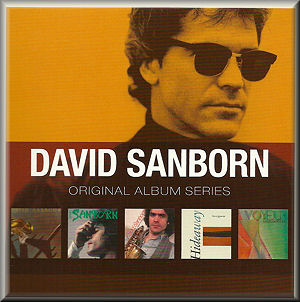CD1: Taking Off
1. Butterfat
2. 'Way 'Cross Georgia
3. Duck Ankles
4. Funky Banana
5. The Whisperer
6. It Took a Long Time
7. Black Light
8. Blue Night
9. Flight
CD2: David Sanborn
1. Indio
2. Smile
3. Mamacita
4. Herbs
5. Concrete Boogie
6. I Do It for Your Love
7. Sophisticated Squaw
8. 7th Ave.
CD3: Heart to Heart
1. Solo
2. Short Visit
3. Theme from "Love is not Enough"
4. Lotus Blossom
5. Heba
6. Sunrise Gospel
7. Anywhere I Wander
CD4: Hideaway
1. Hideaway
2. Carly's Song
3. Anything You Want
4. The Seduction (Love Theme)
5. Lisa
6. If You Would Be Mine
7. Creeper
8. Again an Again
CD5: Voyeur
1. Let's Just Say Goodbye
2. It's You
3. Wake Me When It's Over
4. One in a Million
5. Run for Cover
6. All I Need is You
7. Just for You
A boxed set of five LPs looks like good value - and it is. Warner's Rhino label has assembled five of David Sanborn's LPs from his first solo album (Taking Off) from 1975 to his sixth (Voyeur) from 1981, leaving out 1977's Promise Me the Moon. This is fine, except that the CDs are in cases which reproduce the original album covers, but reducing them in size. As a result, the personnels are almost impossible to read, which I have used as an excuse to omit them (especially as they appear to be extremely numerous), although with a magnifier I can discern such famous names as Mike Brecker, Jon Faddis, Richard Tee, Marcus Miller and Steve Gadd.
But what of the music herein? David Sanborn has often been categorised as playing "smooth jazz". Although he dislikes this label, one has to admit that these five albums contain quite a bit of what you could call smooth jazz. Certainly Sanborn has played with a huge number of jazz and other artists, - from Gil Evans to Jaco Pastorius, from Carly Simon to James Brown. But his solo albums tend to concentrate on the lush, limpid sound which he draws from the saxophone. This is admittedly entrancing but it can become insipid.
At the same time as I received this album, I also had a five-CD set entitled George Duke: Original Album Series (Rhino 812279800 6). The comparison between David Sanborn and George Duke is interesting, because both musicians have worked in the area where jazz crosses over into smooth or easy listening. I found the Sanborn collection more interesting than the Duke package, mainly because George Duke too often used synthetic rhythms and angelic choirs. There are also ethereal choirs on the Sanborn compilation - for instance, in Smile - but in general he is superior to George Duke in being more melodic and less mechanistic, apparently using real musicians instead of machines. The Duke tracks often consist of a funky beat overlaid by romantically echoing keyboard sounds, without much sign of a tune.
I would prefer to hear David Sanborn with a small jazz group rather than the rather overloaded orchestral accompaniments on most of these tracks. My favourites among these five albums are the fourth and fifth, perhaps because I have already owned them on LP for some time, but also because Sanborn seems to surmount the backings and assert his individuality. At his best, his playing has the muscularity of the Brecker Brothers (with whom he has played) at their best. And he can also soar poetically, as he does superbly in Carly's Song and Lisa.
The final album - Voyeur - starts off with a bit of the feeling of Saturday Night Fever, and one expects the Gibb brothers' high-pitched vocals to enter. But the album has its moments, like the yearning One in a Million and the gentle Just for You (with Sanborn accompanied only by Marcus Miller at the piano).
Jazz-rock began as an attempt to add the fiery beat of rock music to jazz, but it soon developed into softer genres, like jazz-funk and even smooth jazz (which often uses jazz-rock's trademark eight-in-a-bar). The danger of blandness has always been present in these types of music - and neither Sanborn nor Duke entirely escaped this peril. But when they steered clear of excessive smoothness, they could both be very exciting players.
Tony Augarde
